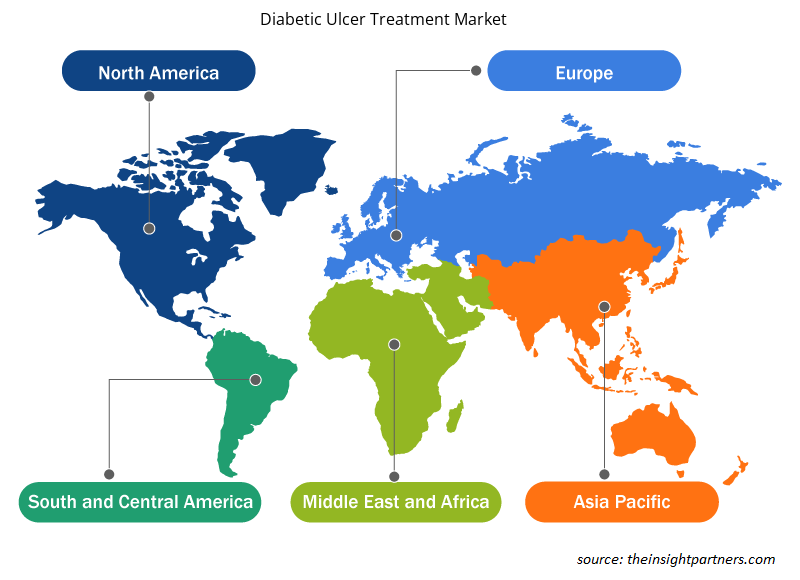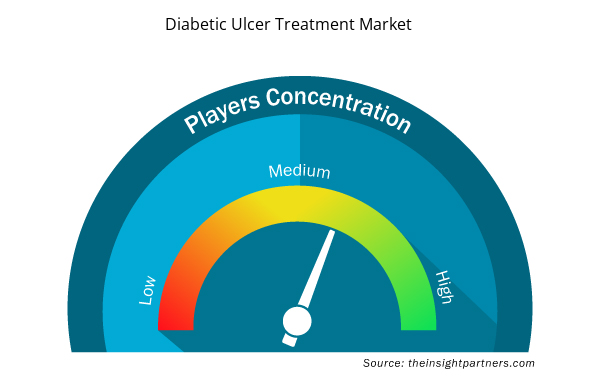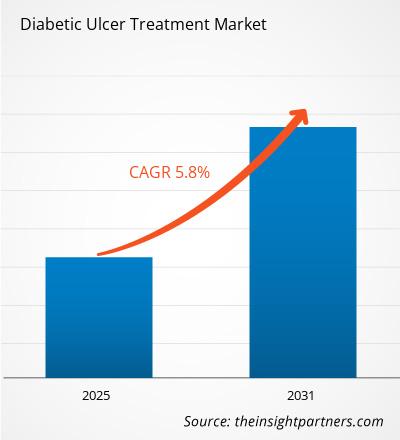Si prevede che il mercato del trattamento dell'ulcera diabetica registrerà un CAGR del 5,8% dal 2025 al 2031, con una dimensione di mercato in espansione da XX milioni di dollari nel 2024 a XX milioni di dollari entro il 2031.
Il report è segmentato per tipo di ulcera (ulcera del piede, ulcera della bocca, ulcera cutanea, ulcera corneale, altre); tipo di trattamento (medicazioni per la cura delle ferite, farmaci biologici, dispositivi terapeutici). Il report presenta inoltre un'analisi basata sull'utente finale (ospedali, centri chirurgici ambulatoriali, assistenza domiciliare, centri sanitari comunitari). L'analisi globale è ulteriormente suddivisa a livello regionale e nei principali paesi. Il report offre il valore in USD per l'analisi e i segmenti di cui sopra.
Scopo del rapporto
Il report Diabetic Ulcer Treatment Market di The Insight Partners mira a descrivere il panorama attuale e la crescita futura, i principali fattori trainanti, le sfide e le opportunità. Ciò fornirà spunti a vari stakeholder aziendali, come:
- Fornitori/produttori di tecnologia: per comprendere le dinamiche di mercato in evoluzione e conoscere le potenziali opportunità di crescita, consentendo loro di prendere decisioni strategiche informate.
- Investitori: condurre un'analisi completa delle tendenze relative al tasso di crescita del mercato, alle proiezioni finanziarie del mercato e alle opportunità esistenti lungo la catena del valore.
- Enti di regolamentazione: regolamentano le politiche e le attività di controllo sul mercato allo scopo di ridurre al minimo gli abusi, preservare la fiducia degli investitori e sostenere l'integrità e la stabilità del mercato.
Segmentazione del mercato del trattamento dell'ulcera diabetica
Tipo di ulcera
- Ulcera del piede
- Ulcera della bocca
- Ulcera cutanea
- Ulcera corneale
- Altri
Tipo di trattamento
- Medicazioni per la cura delle ferite
- Biologici
- Dispositivi terapeutici
Utente finale
- Ospedali
- Centri di chirurgia ambulatoriale
- Assistenza domiciliare
- Centri sanitari comunitari
Geografia
- America del Nord
- Europa
- Asia-Pacifico
- America del Sud e Centro
- Medio Oriente e Africa
Personalizza questo report in base alle tue esigenze
Riceverai la personalizzazione gratuita di qualsiasi report, comprese parti di questo report, o analisi a livello nazionale, pacchetto dati Excel, oltre a usufruire di grandi offerte e sconti per start-up e università
Mercato del trattamento dell'ulcera diabetica: approfondimenti strategici

- Scopri le principali tendenze di mercato in questo rapporto.Questo campione GRATUITO includerà analisi di dati che spaziano dalle tendenze di mercato alle stime e alle previsioni.
Fattori di crescita del mercato del trattamento dell'ulcera diabetica
- Prevalenza crescente di diabete e ferite croniche associate:
le ferite possono essere classificate in acute e croniche, a seconda del tempo impiegato per guarire. Il diabete è una delle emergenze sanitarie più impattanti al mondo nel 21° secolo. Secondo l'American Heart Association, Inc., nel 2024, circa 29,3 milioni di persone negli Stati Uniti hanno ricevuto una diagnosi di diabete e la popolazione diabetica rappresenta circa il 10,5% della popolazione complessiva degli Stati Uniti. - Aumento della popolazione geriatrica:
la popolazione anziana è definita come un gruppo di persone di età pari o superiore a 65 anni. L'invecchiamento è una delle trasformazioni sociali più significative del XXI secolo. L'invecchiamento della popolazione è un problema osservato in modo significativo nelle Americhe, in Europa e nell'Asia Pacifica. Secondo i dati UNFPA, a livello globale le persone di età pari o superiore a 65 anni sono quasi raddoppiate dal 5,5% nel 1974 al 10,3% nel 2024. - Obesità crescente: l'
obesità è collegata al diabete. L'eccesso di grasso corporeo porta al diabete di tipo 2, che a sua volta porta allo sviluppo di ulcere diabetiche. Secondo l'Organizzazione mondiale della sanità (OMS), nel 2022, 1 persona su 8, ovvero 890 persone in tutto il mondo, viveva con l'obesità. Si prevede che questa tendenza continuerà, con un aumento previsto dell'obesità del 35% a livello globale entro il 2030.
Tendenze future del mercato del trattamento dell'ulcera diabetica
- Adozione della stampa 3D nella gestione della cura delle ferite: le ferite causate da vari fattori dovuti al diabete rappresentano un peso significativo per i sistemi sanitari in tutto il mondo. Molti gruppi di ricerca e aziende stanno puntando alla stampa 3D come nuovo trattamento delle ferite da diabete. Ad esempio, i ricercatori dell'Università della California, San Diego, stanno guidando la ricerca sullo sviluppo di scaffold stampati in 3D utilizzando materiali caricati con molecole bioattive che supportano la guarigione delle ferite.
- Prodotti basati sulla nanotecnologia: la ricerca sulla nanotecnologia, in particolare sugli scaffold nanofibrosi (NFS), è cresciuta rapidamente e ha portato a un impatto positivo sul trattamento delle ferite diabetiche. Nei metodi di trattamento adiuvante, una delle alternative pertinenti sono gli scaffold nanofibrosi (NFS), che hanno un potenziale maggiore di quello di qualsiasi altro integratore per farmaci essenziali per accelerare il processo di guarigione delle ferite.
- Medicazioni per ferite a base di chitosano: il chitosano è un polimero naturale, ben studiato, che ha un ampio utilizzo nelle applicazioni biomediche per la sua azione antisettica e la facilitazione della guarigione. Favorisce il drenaggio e previene l'accumulo di essudati; inoltre, il CS agisce come letto di autoinnesto nella terapia delle ferite. La crescente preferenza per le medicazioni a base di chitosano è una delle principali tendenze osservate nelle regioni sviluppate.
Opportunità di mercato per il trattamento dell'ulcera diabetica
- Aumento dell'adozione di dispositivi per la terapia a pressione negativa delle ferite (NPWT): è stato clinicamente dimostrato che i dispositivi NPWT guariscono le ferite e riducono il rischio di complicazioni nelle ulcere diabetiche. L'adozione di questi dispositivi, tuttavia, rimane una sfida a causa del loro costo e della necessità di complessità di utilizzo. Poiché la tecnologia è in continua evoluzione, diventa un'opportunità per le aziende di ideare dispositivi NPWT più convenienti e facili da usare che possano aumentare il tasso di adozione e sfruttare il mercato.
- Nuovi prodotti per il trattamento delle ferite: lo sviluppo di nuovi prodotti per la cura delle ferite in grado di indurre una guarigione più rapida con una ridotta possibilità di complicazioni nelle ulcere diabetiche sono interessanti vie di applicazione. Possono includere nanomateriali, molecole bioattive e superfici biomimetiche tra gli altri. I prodotti offrono un vantaggio offrendo una migliore efficacia e migliori risultati per i pazienti. I nuovi prodotti per la cura delle ferite troverebbero probabilmente una quota di mercato significativa per le aziende che investono nella sua ricerca e sviluppo.
- Elevata richiesta di dispositivi di scarico: questi dispositivi di scarico sono realizzati in modo tale da ridurre la pressione e alleviare il disagio causato da un'ulcera diabetica. Con l'aumento dei casi di diabete in tutto il mondo, i dispositivi di scarico della pressione sono molto richiesti, soprattutto nelle regioni sottosviluppate. Le aziende che investono in R&S in dispositivi di scarico innovativi trarranno una buona quantità di benefici.
Approfondimenti regionali sul mercato del trattamento dell'ulcera diabetica
Le tendenze regionali e i fattori che influenzano il mercato del trattamento dell'ulcera diabetica durante il periodo di previsione sono stati ampiamente spiegati dagli analisti di Insight Partners. Questa sezione discute anche i segmenti del mercato del trattamento dell'ulcera diabetica e la geografia in Nord America, Europa, Asia Pacifico, Medio Oriente e Africa e America meridionale e centrale.

- Ottieni i dati specifici regionali per il mercato del trattamento dell'ulcera diabetica
Ambito del rapporto di mercato sul trattamento dell'ulcera diabetica
| Attributo del report | Dettagli |
|---|---|
| Dimensioni del mercato nel 2024 | XX milioni di dollari USA |
| Dimensioni del mercato entro il 2031 | XX milioni di dollari USA |
| CAGR globale (2025 - 2031) | 5,8% |
| Dati storici | 2021-2023 |
| Periodo di previsione | 2025-2031 |
| Segmenti coperti | Per tipo di ulcera
|
| Regioni e Paesi coperti | America del Nord
|
| Leader di mercato e profili aziendali chiave |
|
Densità degli operatori del mercato del trattamento dell'ulcera diabetica: comprendere il suo impatto sulle dinamiche aziendali
Il mercato del trattamento dell'ulcera diabetica sta crescendo rapidamente, spinto dalla crescente domanda degli utenti finali dovuta a fattori quali l'evoluzione delle preferenze dei consumatori, i progressi tecnologici e una maggiore consapevolezza dei benefici del prodotto. Con l'aumento della domanda, le aziende stanno ampliando le loro offerte, innovando per soddisfare le esigenze dei consumatori e capitalizzando sulle tendenze emergenti, il che alimenta ulteriormente la crescita del mercato.
La densità degli operatori di mercato si riferisce alla distribuzione di aziende o società che operano in un particolare mercato o settore. Indica quanti concorrenti (operatori di mercato) sono presenti in un dato spazio di mercato in relazione alle sue dimensioni o al valore di mercato totale.
Le principali aziende che operano nel mercato del trattamento dell'ulcera diabetica sono:
- ConvaTec, Inc.
- Società a responsabilità limitata Acelity LP Inc.
- 3 milioni
- Coloplast A/S
- Società anonima Smith & Nephew Plc.
Disclaimer : le aziende elencate sopra non sono classificate secondo un ordine particolare.

- Ottieni una panoramica dei principali attori del mercato del trattamento dell'ulcera diabetica
Punti chiave di vendita
- Copertura completa: il rapporto copre in modo completo l'analisi di prodotti, servizi, tipologie e utenti finali del mercato del trattamento dell'ulcera diabetica, fornendo una panoramica olistica.
- Analisi degli esperti: il rapporto è compilato sulla base della conoscenza approfondita di esperti e analisti del settore.
- Informazioni aggiornate: il rapporto garantisce la pertinenza aziendale grazie alla copertura di informazioni recenti e tendenze nei dati.
- Opzioni di personalizzazione: questo report può essere personalizzato per soddisfare le esigenze specifiche del cliente e adattarsi in modo appropriato alle strategie aziendali.
Il rapporto di ricerca sul mercato del trattamento dell'ulcera diabetica può, quindi, aiutare a guidare il percorso di decodificazione e comprensione dello scenario del settore e delle prospettive di crescita. Sebbene possano esserci alcune preoccupazioni valide, i vantaggi complessivi di questo rapporto tendono a superare gli svantaggi.
- Analisi storica (2 anni), anno base, previsione (7 anni) con CAGR
- Analisi PEST e SWOT
- Valore/volume delle dimensioni del mercato - Globale, regionale, nazionale
- Industria e panorama competitivo
- Set di dati Excel



Report Coverage
Revenue forecast, Company Analysis, Industry landscape, Growth factors, and Trends

Segment Covered
This text is related
to segments covered.

Regional Scope
North America, Europe, Asia Pacific, Middle East & Africa, South & Central America

Country Scope
This text is related
to country scope.
Domande frequenti
The diabetes ulcer treatment market is estimated to grow with a CAGR of 5.8% from 2023 to 2031
Asia-Pacific region is likely to witness the fastest growth rate during the forecast period.
The market drivers include the increasing prevalence of diabetes and rising geriatric population, which are driving the diabetes ulcer treatment market
The diabetes ulcer treatment market majorly consists of players such as ConvaTec, Smith & Nephew Plc, B. Braun Melsungen AG among others.
Nanotechnology-based products is likely to remain the key trend during the forecast period.
North America dominated the diabetic ulcer treatment market in 2023
Trends and growth analysis reports related to Life Sciences : READ MORE..
1. ConvaTec, Inc.2. Acelity L.P. Inc.3. 3M4. Coloplast A/S5. Smith & Nephew Plc.6. B. Braun Melsungen AG7. Medline Industries, Inc.8. Medtronic Plc.9. Cardinal Health10. Molnlycke Health Care AB
The Insight Partners performs research in 4 major stages: Data Collection & Secondary Research, Primary Research, Data Analysis and Data Triangulation & Final Review.
- Data Collection and Secondary Research:
As a market research and consulting firm operating from a decade, we have published and advised several client across the globe. First step for any study will start with an assessment of currently available data and insights from existing reports. Further, historical and current market information is collected from Investor Presentations, Annual Reports, SEC Filings, etc., and other information related to company’s performance and market positioning are gathered from Paid Databases (Factiva, Hoovers, and Reuters) and various other publications available in public domain.
Several associations trade associates, technical forums, institutes, societies and organization are accessed to gain technical as well as market related insights through their publications such as research papers, blogs and press releases related to the studies are referred to get cues about the market. Further, white papers, journals, magazines, and other news articles published in last 3 years are scrutinized and analyzed to understand the current market trends.
- Primary Research:
The primarily interview analysis comprise of data obtained from industry participants interview and answers to survey questions gathered by in-house primary team.
For primary research, interviews are conducted with industry experts/CEOs/Marketing Managers/VPs/Subject Matter Experts from both demand and supply side to get a 360-degree view of the market. The primary team conducts several interviews based on the complexity of the markets to understand the various market trends and dynamics which makes research more credible and precise.
A typical research interview fulfils the following functions:
- Provides first-hand information on the market size, market trends, growth trends, competitive landscape, and outlook
- Validates and strengthens in-house secondary research findings
- Develops the analysis team’s expertise and market understanding
Primary research involves email interactions and telephone interviews for each market, category, segment, and sub-segment across geographies. The participants who typically take part in such a process include, but are not limited to:
- Industry participants: VPs, business development managers, market intelligence managers and national sales managers
- Outside experts: Valuation experts, research analysts and key opinion leaders specializing in the electronics and semiconductor industry.
Below is the breakup of our primary respondents by company, designation, and region:

Once we receive the confirmation from primary research sources or primary respondents, we finalize the base year market estimation and forecast the data as per the macroeconomic and microeconomic factors assessed during data collection.
- Data Analysis:
Once data is validated through both secondary as well as primary respondents, we finalize the market estimations by hypothesis formulation and factor analysis at regional and country level.
- Macro-Economic Factor Analysis:
We analyse macroeconomic indicators such the gross domestic product (GDP), increase in the demand for goods and services across industries, technological advancement, regional economic growth, governmental policies, the influence of COVID-19, PEST analysis, and other aspects. This analysis aids in setting benchmarks for various nations/regions and approximating market splits. Additionally, the general trend of the aforementioned components aid in determining the market's development possibilities.
- Country Level Data:
Various factors that are especially aligned to the country are taken into account to determine the market size for a certain area and country, including the presence of vendors, such as headquarters and offices, the country's GDP, demand patterns, and industry growth. To comprehend the market dynamics for the nation, a number of growth variables, inhibitors, application areas, and current market trends are researched. The aforementioned elements aid in determining the country's overall market's growth potential.
- Company Profile:
The “Table of Contents” is formulated by listing and analyzing more than 25 - 30 companies operating in the market ecosystem across geographies. However, we profile only 10 companies as a standard practice in our syndicate reports. These 10 companies comprise leading, emerging, and regional players. Nonetheless, our analysis is not restricted to the 10 listed companies, we also analyze other companies present in the market to develop a holistic view and understand the prevailing trends. The “Company Profiles” section in the report covers key facts, business description, products & services, financial information, SWOT analysis, and key developments. The financial information presented is extracted from the annual reports and official documents of the publicly listed companies. Upon collecting the information for the sections of respective companies, we verify them via various primary sources and then compile the data in respective company profiles. The company level information helps us in deriving the base number as well as in forecasting the market size.
- Developing Base Number:
Aggregation of sales statistics (2020-2022) and macro-economic factor, and other secondary and primary research insights are utilized to arrive at base number and related market shares for 2022. The data gaps are identified in this step and relevant market data is analyzed, collected from paid primary interviews or databases. On finalizing the base year market size, forecasts are developed on the basis of macro-economic, industry and market growth factors and company level analysis.
- Data Triangulation and Final Review:
The market findings and base year market size calculations are validated from supply as well as demand side. Demand side validations are based on macro-economic factor analysis and benchmarks for respective regions and countries. In case of supply side validations, revenues of major companies are estimated (in case not available) based on industry benchmark, approximate number of employees, product portfolio, and primary interviews revenues are gathered. Further revenue from target product/service segment is assessed to avoid overshooting of market statistics. In case of heavy deviations between supply and demand side values, all thes steps are repeated to achieve synchronization.
We follow an iterative model, wherein we share our research findings with Subject Matter Experts (SME’s) and Key Opinion Leaders (KOLs) until consensus view of the market is not formulated – this model negates any drastic deviation in the opinions of experts. Only validated and universally acceptable research findings are quoted in our reports.
We have important check points that we use to validate our research findings – which we call – data triangulation, where we validate the information, we generate from secondary sources with primary interviews and then we re-validate with our internal data bases and Subject matter experts. This comprehensive model enables us to deliver high quality, reliable data in shortest possible time.

 Ottieni un campione gratuito per questo repot
Ottieni un campione gratuito per questo repot